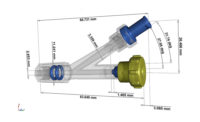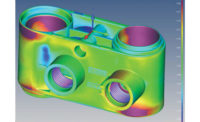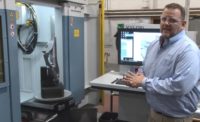Effective quality management is crucial for the success of aerospace, an industry where failure is simply not an option. Faulty designs and poorly manufactured parts not only lead to wasted resources and loss of profits, but also jeopardize company reputation and can compromise public safety. These concerns eventually led to widespread adoption of standards to implement stringent quality and safety requirements for aerospace manufacturing.
The quest for quality is also helping push the boundaries of innovation in aerospace, leading to progress with lightweighting to improve fuel efficiency and greater usage of advanced materials like super alloys to increase aircraft performance and durability. The aerospace industry has also been an early adopter of additive manufacturing, which enables weight savings and space optimization while allowing for complex designs through a simplified fabrication process.
Additive Manufacturing in Aerospace
Additive manufacturing is making it possible to build complex parts that would be near impossible to make with conventional machining. Aerospace manufacturers have turned to 3D printing solutions to shorten supply chains and reduce production time and costs, all while producing components that are lightweight yet strong. According to a recent Research and Markets report, the aerospace 3D printing market is forecasted to grow from $700 million in 2017 to $3 billion by 2022.
Growth is spurred on by the fact that 3D printing is no longer just for making prototypes, but also for manufacturing fully functioning parts for mainstream production. In fact, the housing for a temperature sensor for GE’s commercial jet engines became the first mainstream 3D-printed part certified by the U.S. Federal Aviation Administration. GE has also developed next-generation LEAP jet engines, which hold 3D-printed fuel nozzles and feature new materials like ceramic composites and carbon-fiber fan blades.
The revolutionary technology is also accelerating aerospace design and prototyping, reducing what would normally take years to mere months or weeks.
While additive manufacturing is closing the gap between design and production, quality assurance through accurate inspection and measurement remains vitally important. Consistency between parts is a prime concern, with the need to maintain quality even greater due to the variability of 3D printing. As the industry invests in new technologies and materials, aerospace manufacturers need inspection technologies that can keep up with the pace of innovation and adapt to disruptive technologies.
Industrial CT Scanning for Aerospace Inspection
Testing has always been a crucial step in the management of quality. But since aerospace parts tend to be high value, destructive testing does not always make economic sense for large and expensive components. Nondestructive testing is thus an essential tool for quality assurance in the aerospace industry. Sub-surface NDT is especially useful for aerospace as it provides insight into critical internal features that other methods could miss.
While many NDT methods are available, industrial computed tomography (CT) is redefining the limits of inspection. Initially developed for medical applications, industrial CT has since found extensive usage among numerous industries for its ability to reveal the internal physical features of an object without destructive testing. As an advanced radiographic testing technique, it produces a densiometric dataset by imaging an object using an array of X-ray images, which are compiled together using specialized software to form a 3D model.
The appeal of CT for inspection is rooted in its versatility and speed, giving aerospace manufacturers a competitive advantage when time is the critical factor. CT can inspect a wide variety of metallic and non-metallic materials of varying densities with little to no fixturing. It can also examine the internal features of complex shapes and geometries, identifying and characterizing defects like cracks, voids, wall thickness, inclusions, porosities, residual powder, and other types of defects.
The technology offers the advantage of rapid inspection, validating complex measurements for both external and internal geometries in less time. What would normally take up months of inspection time is reduced to weeks, avoiding slowdowns with validation of manufactured parts. CT provides the crucial data that reduces the cycle time, allowing for improvement before finalization of the design. In this way, CT helps support design innovations in the aerospace industry through a rapid inspection process.
The CT Advantage
Since aerospace quality control often requires extensive sampling of comparison points to ensure that production parts meet original CAD designs, CT is an optimal inspection method due to the high data density and precision of its scans. Unlike other testing methods, it also provides a permanent visual record for future use. This is especially valuable for comparing analyses of components before and after treatments or at different stages of manufacturing and throughout the lifecycle of a component for archival purposes. For example, scan data can be used to assess component wear over time, such as monitoring crack growth to determine critical flaw sizes or for creating a digital archive of parts through reverse engineering.
For First Article Inspection (FAI), CT provides accurate data for objective verification and documentation of engineered designs and tolerances, with consistent turnaround time regardless of measurement complexity. Alignment schemes can be customized according to project requirements, including best fit, datum, feature-based, and other predetermined parameters. The high repeatability of measurements with CT allows for greater confidence when comparing data over multiple part revisions. Any subsequent drawing revisions will not require new scans, saving time when validating updated designs.
CT can also be used for conducting failure investigations, with the ability to inspect internal features of complex components that have undergone fatigue or mechanical testing. This means that it can inspect a failed part without changing the conditions of failure, making it a highly valuable tool for failure analysis. CT allows for virtual sectioning that is more reliable and less tedious than traditional techniques. In the case of electrical connectors, CT slices can provide crucial information on connector condition, fit of components, and bonded components.
The high initial costs of equipment and the expertise required for operation may dissuade manufacturers from making full use of CT technology within their facilities. However, third party inspection labs can provide the valuable service manufacturers need, offering an array of inspection options with multiple systems, along with trained technical staff experienced in operating the systems and analyzing the data. As key enablers of innovation, these facilities have a supporting but crucial role in shaping the future of the aerospace industry.
Current Developments in CT Technology
Due to advances in both hardware and software, CT is seeing expansion of its inspection repertoire and capabilities. Underlying these developments is the need for greater computing power and more sophisticated algorithms to accommodate the high data density of this method. These advancements also reflect the growing trend of big data and automation characteristic of Industry 4.0 and the Industrial Internet of Things (IIoT).
“Over recent years, there have been giant leaps in CT technology, which have allowed CT to play an important role in production quality control,” writes Oliver Brunke, product manager of CT systems at GE Measurement & Control, in Quality. “These innovations have seen volumetric data collection and reconstruction increase by factors greater than ten, while system and data workflows have been introduced to create simplified production line workflows, combined with easy and accessible data management.” (www.qualitymag.com/articles/92672-industrial-x-ray-ct-quality-control-from-the-lab-to-the-production-floor)
Fast CT scanning solutions are also being developed that are capable of inspecting industrial parts in less than an hour, allowing for production run inspection of products. Another innovation involves the use of higher energy systems for inspection of larger parts and denser materials, and multi-energy scanning which can lead to better image quality with multi-material components. These advancements expand the range of applicability of CT scanning, allowing for inspection of larger objects in their native orientation as well as higher density materials which lower energy systems cannot penetrate.
Summary
As more manufacturers are becoming aware of the benefits of the technology, CT is moving toward mainstream use for aerospace part inspection. Not only is it helping to qualify pre-production parts quickly and accurately, but CT is also finding increased usage for high volume inspection during production stages. In all, industrial CT scanning is providing definitive and rapid results in a manufacturing landscape where competition is intense and change is the norm.





